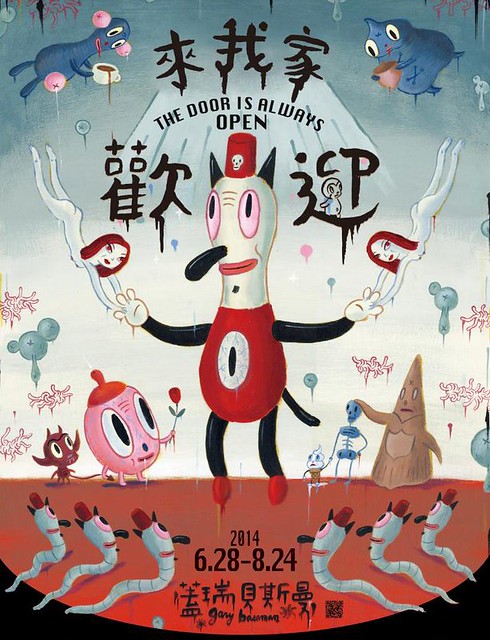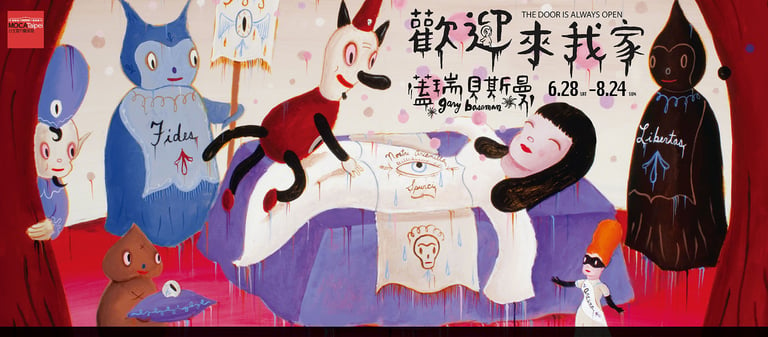We didn’t lose our inner child. We turned it into ArT Toys and More...with purpose.
The Door is Always Open — Taipei, 2014
Where Memory Crossed Oceans and the ArT Toy Became a Ritual of Emotion with Gary Baseman. The Door is Always Open. Taipei #00022 — TNoTToys Publications
TNOTTOYS PUBLICATIONS1000 ICONIC ART TOY EXHIBITIONS
Sergio Pampliega Campo & Crsitina A. del Chicca
🌀 This post is part of an ongoing research series from Art Toy Gama’s editorial division:
📚 This Is Not a Book About Art Toy Exhibitions & ToyCons
Context Matters
Taipei, 2014.
The Museum of Contemporary Art (MOCA) opens not just its doors, but its dreams.
After Los Angeles, where Baseman’s house became a museum, Taipei receives that same house; translated, reimagined, spiritualized.
This is not a replica; it’s a reincarnation.
The West had seen intimacy.
The East would now see initiation.
Baseman’s The Door is Always Open in Taipei transforms personal confession into cultural dialogue.
Here, the domestic universe he built in Los Angeles mutates into a universal one: where nostalgia, mythology, and play merge into a single emotional language.
The ArT Toy is no longer the artifact of one man’s childhood; it becomes the shared memory of many.
Taipei is the middle act of the trilogy: the threshold where the personal turns collective.
Where vulnerability learns to speak two languages.
Where Memory travels with a passport stamped in emotion.
POSTER Reading I: The Ascension of Toby
A sky of pale blues and dripping reds.
A central figure stands — not human, but humanoid — with the body of a puppet and the posture of a prophet.
It’s Toby, but not the same Toby that stared through the keyhole in Los Angeles.
This Toby has stepped out of the dark.
He’s no longer being watched.
He is now the one welcoming You in.
Above his head, the title appears in two languages — English and Chinese — THE DOOR IS ALWAYS OPEN / 歡迎來我家.
This bilingual fusion changes the energy of the phrase.
In English, it’s invitation.
In Chinese, it’s homecoming.
It reads as: “Welcome as if you were returning home.”
It’s not about entering Baseman’s world anymore; it’s about recognizing it as your own.
🔑 Symbolic Core
This POSTER converts the visual architecture of the keyhole into open space.
The claustrophobia of Los Angeles has dissolved into cosmic air.
The background expands; the characters breathe.
Toby, arms extended, isn’t holding trophies or heads; he’s being held.
Two feminine figures, delicate yet spectral, reach toward him as if to keep him within their orbit.
They don’t restrain; they tether.
It’s not a gesture of control, but of emotional gravity.
Toby stands at the center of his own aura, pulled between freedom and belonging, between transcendence and memory.
He doesn’t lead; he’s being remembered by his own creation.
He becomes priest and jester.
Child and shaman.
The fool who knows the ritual better than the gods.
Around him, smaller creatures orbit; an ecosystem of empathy.
They are both toys and spirits, painted in red and pale flesh tones that recall wounds and laughter at once.
The repetition remains, but its meaning shifts: from trauma to transcendence.
Here, the ArT Toy ceases to be an object of nostalgia; it becomes a vehicle of rebirth.
🧠 Typography and Language as Cultural Conduit
In Taipei, language stops being a tool of translation and becomes a ritual of transformation.
Below the bilingual title, Baseman’s own name appears reborn in Chinese characters — 盖瑞•贝斯曼 (Gài ruì bèi sī màn) — a phonetic echo of Gary Baseman.
But this isn’t simple transcription; it’s metamorphosis.
To be rewritten in another alphabet is to surrender control.
Baseman allows his identity to dissolve into a new cultural body — no longer Western artist, but shared myth.
It’s the reverse colonization of imagination:
the moment when the East doesn’t imitate the West, it absorbs it.
The way those characters appear is equally crucial.
They drip, as if drawn with wet ink that refuses to dry.
Each stroke looks less like handwriting and more like a wound slowly forming.
The characters don’t inform; they emanate.
They feel painted during a ceremony, halfway between language and offering.
Here, typography becomes substance.
Writing becomes matter.
And language — trembling, bleeding, hybrid — turns into what every ArT Toy ultimately is:
a vessel of emotion disguised as form.
Neuroaesthetically, these characters activate a dual response:
1. For Chinese readers, meaning and form collide: the literal message remains, but its emotional weight distorts through gesture.
2. For non-Chinese readers, the symbols operate as living drawings, emotional hieroglyphs, or even small spells.
This connects directly to the Art Toy Gama Manifesto:
✴️ The absurd as language: using an ancestral script to express a contemporary emotional code fractures the linear history of visual culture.
✴️ The emotional as memory: the dripping ink behaves like tears, recalling wounds and recollections that precede comprehension.
✴️ The small act as revolution: replacing institutional typography with trembling, handmade script transforms design into confession.
🎯 In essence, these Chinese characters aren’t translation; they’re emotional devices, cultural bridges, visual mantras.
They don’t say “enter.”
They whisper: “What You thought was Yours now belongs to Us.”
And they say it in the ink of memories You didn’t know You carried.
🎨 Color as Transcendence
The palette expands from the previous Exhibition.
Gone is the oppressive black; here the air breathes pastel.
But don’t mistake light for peace.
Red: still blood, still pulse, now ritual instead of rupture.
Blue: melancholia made sky.
Beige and white: skin, fragility, silence.
The hues drip, melt, blend…as if painted with memory instead of pigment.
Each shade feels lived.
This is not a cheerful world.
It’s a soft apocalypse: playful, beautiful, and bruised.
🌀 Composition and Emotional Structure
Every element orbits Toby.
His circular belly, his fez marked with a skull, his open arms; all construct a symbolic geometry of invitation.
This isn’t symmetry; it’s gravity.
The design doesn’t persuade; it pulls.
Baseman no longer hides behind metaphor.
The ArT Toy becomes the altar.
The poster itself functions as a ritual diagram: a visual chant that reprograms the viewer.
It tells You:
You’ve already crossed the threshold. Now, stay.
POSTER Reading II — The Dream Ritual
Horizontal, cinematic, theatrical.
This second POSTER from the Taipei Exhibition abandons the stage of introduction and enters the dream itself.
The curtains open.
A girl lies on a white bed.
Is she asleep?
Is she gone?
Baseman never answers.
Toby climbs onto the bed, not to wake her, but to witness her.
Around them, other characters stand; not random, but allegorical:
Fides, Libertas, Sincerus, Spunci.
Faith. Freedom. Sincerity. Error.
They are not virtues to admire — they are emotional states to inhabit.
Every name stitched into fabric. Every tear a symbol.
The room becomes a chapel for the subconscious.
The curtain is not decoration; it’s the border between reality and reverie.
This isn’t a bedroom.
It’s a stage for rebirth.
🧩 Symbolic Reading
The woman on the bed is not a figure.
She is Memory itself: sleeping, forgotten, waiting to be reawakened.
Her body bears the marks of Baseman’s visual language:
Nostri Anomella...a half-Latin phrase that sounds like a spell.
Spunci ...the personification of emotional mistake.
The crying eye...the symbol of vulnerability as truth.
Around her, the creatures stand in silence, each embodying an inner virtue or fracture.
Toby, half-dog and half-devil, acts as guide… not savior.
He doesn’t open the door. He walks through it first.
And by doing so, he shows You how.
✍️ Typography and Language
Here, the dual-language dialogue intensifies.
Chinese characters dominate the upper space: bold, dripping, assertive.
English remains beneath, smaller but glowing.
Together, they perform balance: East and West, symbol and sentence, ritual and confession.
The script no longer describes; it chants.
Every letter feels alive, vibrating between ink and voice.
The handwriting of Gary Baseman at the bottom reappears, childlike and sincere; the universal mark of authorship-as-memory.
🎨 Color as Emotional Flesh
This is a painting that bleeds emotion.
The palette: red, violet, white.
The tones shift from theatre to ceremony.
Red: not just blood now: curtain, love, danger.
Violet: the bruise of transformation, the twilight between living and remembering.
White: silence turned visible.
The colors don’t stay still. They drip like tears or melted wax.
Everything in this poster feels like it’s weeping softly.
Even the light looks tired.
And yet, it glows.
💭 Emotional Function
This POSTER does not ask You to visit the Exhibition.
It asks You to remember.
It’s not marketing.
It’s mourning.
The ArT Toys, placed around the bed, have stopped “playing.”
They are witnesses now… guardians of the transition between dream and waking, between life and Memory.
It’s not design.
It’s vigil.
The POSTER becomes psychography… an emotional MRI of Baseman’s universe.
What the Exhibition Showed: The House Becomes a Ritual
In Taipei, The Door is Always Open shifted from domestic reconstruction to spiritual translation.
The Skirball house was reborn, this time inside a museum that already treated memory as a living organism.
The rooms remained — kitchen, living room, childhood bedroom — but their function evolved.
Each space became a symbolic vessel where the ArT Toy acted as medium, not object.
Visitors didn’t tour; they participated.
They entered not just Baseman’s home, but their own inner one — reflected through plastic, paint, and projection.
Here, the ArT Toy became both relic and oracle.
A pop-surrealist ritual tool.
Every piece of vinyl whispered something that no wall text could translate.
Why It Mattered: The Emotional Globalization of the ArT Toy
If Los Angeles was the confession, Taipei was the translation.
It proved that vulnerability was a universal language … one that required no subtitles.
This Exhibition made the ArT Toy cross cultural borders not as a trend, but as an emotional archetype.
The hybrid of text and symbol, English and Mandarin, domestic and mythic; all served one purpose:
to make Memory global.
While pop surrealism had flirted with Asia before, this was different.
This was not export; it was exchange.
Taipei didn’t “host” Baseman.
It absorbed him.
Here, the ArT Toy became a new cultural script; emotional, tactile, transcultural.
It showed that what began as one artist’s vocabulary could become a movement’s grammar.
This mattered because it transformed the private mythology of a Los Angeles artist into a collective ritual of empathy.
And it whispered again, louder this time:
Dis(Play) is the New Memory.
Legacy & Mutation
Taipei confirmed what Los Angeles had only whispered: The Door is Always Open was no longer an Exhibition; it was a pilgrimage.
The door that first cracked in California had no hinges anymore. It stayed open, permanently.
From West to East, the ArT Toy evolved from collectible to confession, from design object to emotional interface.
It carried Memory across oceans, proving that emotion travels better than language.
Taipei wasn’t translation; it was transformation.
After Taipei, the ArT Toy Movement could no longer pretend to be underground.
It had entered the neural architecture of contemporary culture — as Nike did with lifestyle, as Apple did with design — not through marketing, but through meaning.
The museum became a playground. The ArT Toy, a relic. The collector, a believer.
Toby — small, imperfect, persistent — became the emotional interface of a global generation: the one that hides pain behind humor, and builds identity through absurdity.
He ceased to be a mascot. He became memory itself.
This Exhibition turned the museum into an imaginary house: a sanctuary of emotions divided into rooms of life: welcome, celebration, inheritance, play, labor, and dream.
Each chamber was an emotional function; each object, a pulse of biography.
The energy behind the project was not curatorial: it was devotional.
Baseman transformed biography into mythology.
He didn’t display his life; he performed it.
He offered his childhood, fears, losses, and rituals as a living altar.
The dream became narrative.
The sleeping girl, surrounded by virtues — Fides, Libertas, Sincerus — revealed that Baseman’s art is not about invention, but healing.
The Door is Always Open is not only the passage to a house — it is the entry to the subconscious.
This chapter expanded the Movement’s geography and its grammar.
It made the absurd universal.
It made the intimate public.
It made Play sacred.
And it prepared the way for Shanghai, where the myth would become monument.
Final Thought: Art Toy Gama Perspective: Dis(Play) in Cultural Translation
The two POSTER of Taipei form a diptych of awakening.
The first: Toby reborn, arms open, performing welcome.
The second: the dream, the vigil, the rite of remembering.
Together they tell one truth:
The Door is Always Open is not about entering someone else’s home : it’s about realizing You never left Your own.
This Exhibition did not travel; it transformed.
It taught that the ArT Toy is not global because it’s trendy,
but because emotion doesn’t need translation.
Taipei turned display into ritual.
The POSTER became prophecy.
And the ArT Toy became language.
Baseman didn’t just show his home … he translated his psyche into architecture.
Every wall, every plush, every trembling line of calligraphy acted as a neuron of collective nostalgia.
This is what we at Art Toy Gama believe:
that the ArT Toy is not decoration, but decoding.
Not an object of desire, but a device for emotional survival.
The Taipei chapter is the hinge of the trilogy:
the moment when the absurd became spiritual,
and the toy learned to pray.
Join The First and Only Art Toy Newsletter Society in the World here: https://emails.arttoygama.com/l/email-subscription
🔗 ENTER THE ART TOY GAMA STORE
#1000IconicArTToyExhibitions
We’re currently building an Upcoming Publication that explores and celebrates
the most iconic and influential Art Toy exhibitions around the world.
Each article in this series helps document, reflect, and invite the community
to take part in constructing this cultural archive — one exhibition at a time.
We’ve seen countless exhibitions since then: small and large, modest and monumental.
And we love them all.
No matter where they take place or the resources behind them,
every ArT Toy show adds something to the Movement.
Some will make history, others will make Memory. All of them matter.
This is not just documentation.
This is Dis(Play) in the making.
And You’re part of it.
Art Toy Gama Legacy
#ArTToyGamaLegacy
Art Toys. Paintings. Fine Art Prints. Not what You expect.
Real collectors don't follow trends—they redefine them
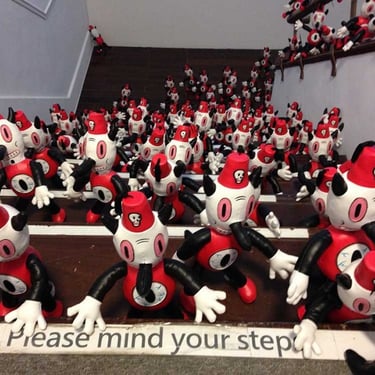

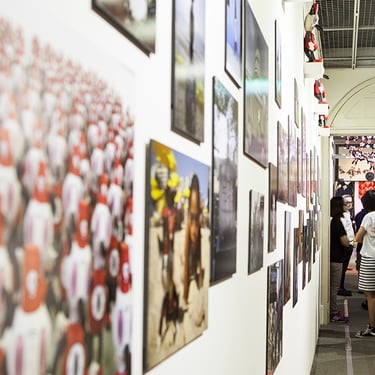
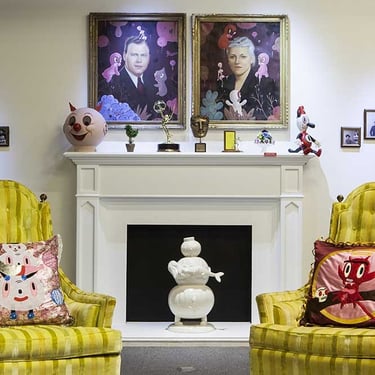

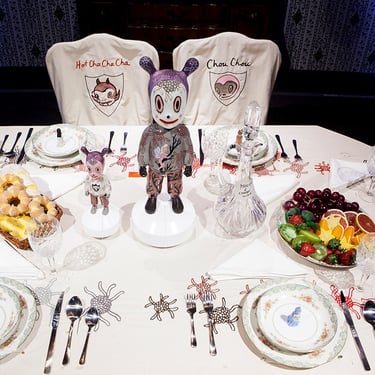
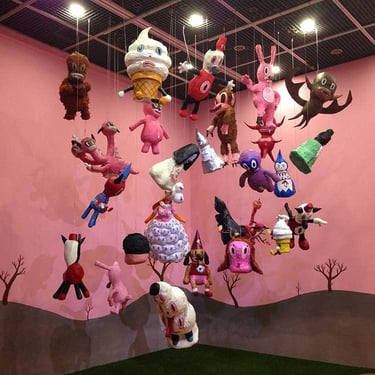
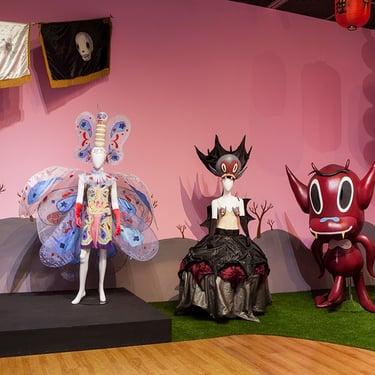
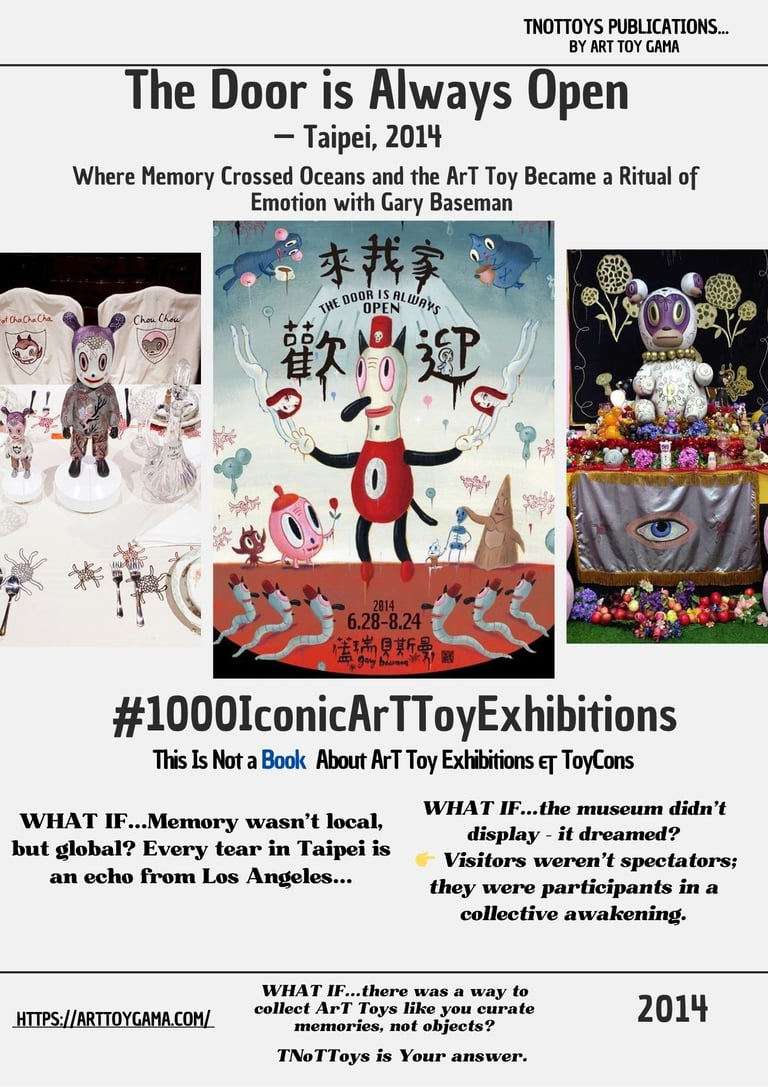


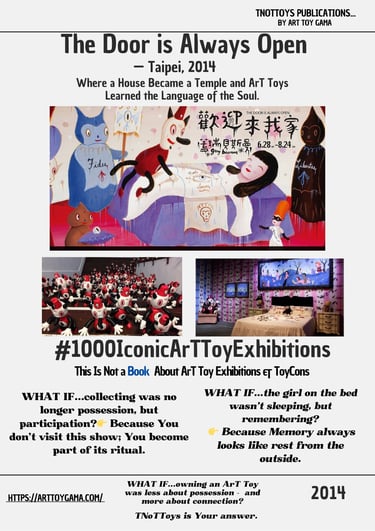
We didn’t lose our inner child. We turned it into Art.
You collecting, or just hoarding what the algorithm spoon-feeds you?
contact
© 2025. All rights reserved.

